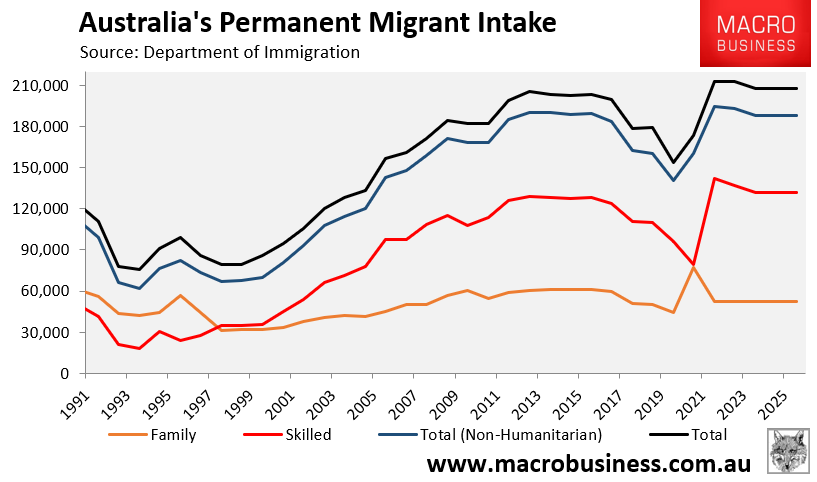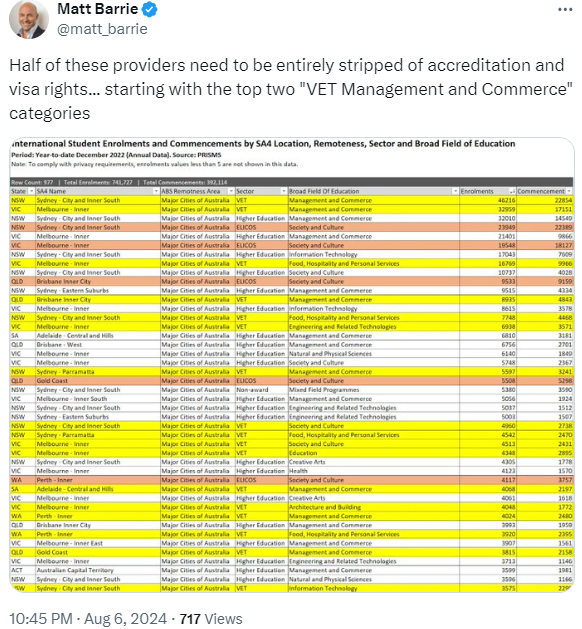Claire Field, a former regulator of the vocational training sector, warned in 2022 that a large number of South Asian students were arriving in Australia in “response to the unlimited work rights now available to those on Australian student visas”, enrolling in “lower quality and cheaper vocational colleges” to live and work.
The surge in arrivals corresponded with the former Morrison Government’s decision to lift the cap on the number of hours overseas students could work while studying and to grant Vocational Education and Training (VET) graduates a two-year Temporary Graduate visa.
Subsequently, the Albanese Government announced at the 2022 Jobs & Skills Summit that it would uncap work hours for an additional year and extend post-study work rights for two years for recent graduates with specified degrees:

Source: Jobs & Skills Summit
Labor also increased the permanent (non-humanitarian) immigration intake to a new high of 195,000 per year (now 185,000), increasing the likelihood of students gaining permanent residency:

Shortly after the Albanese Government’s 2022 reforms, Labor backbencher Julian Hill warned that Australia’s international education system had devolved into a “Ponzi scheme” for luring non-legitimate students to the country with unrestricted work rights and permanent residency, which was being ruthlessly exploited by unethical education agents.
“Uncapped work rights is being misused by agents in many parts of the world who are flogging our precious student visa as some kind of cheap, low rent work visa. No one should permit that to continue”, Hill said.
“We know that the incentive of a permanent visa to Australia is like a golden ticket from Willy Wonka’s chocolate bar”.
“It’s too powerful an incentive that would drive and pervert behaviour by providers, and some students”, Hill warned.
Hill’s concerns were justified, with international student enrolments exploding, led by students from South Asia:

VET enrolments experienced one of the largest proportionate increases for reasons outlined by Claire Field above.

In recognition that it had made a mistake, the Albanese Government belatedly tightened requirements and rules surrounding student visas, including:
- Reducing the number of hours that overseas students can work during the semester to 24 per week. However, this is four hours more than was allowed prior to the pandemic and ranks among the maximum legal hours in the globe. In addition, students can work an unlimited number of hours between semesters.
- Increasing the student visa fee from $710 to $1,600 and then to $2,000.
- Ending the ‘visa hopping’ loopholes that permitted international students and other temporary visa holders to constantly extend their stay in Australia, sometimes forever.
- Visitor visa holders are prohibited from applying for student visas onshore.
- Increasing the amount of funds that student visa holders must have access to support their stay in Australia (even though it can be circumvented).
On the other hand, Labor also effectively increased the permanent migrant intake to 235,000 in 2023 when it gave New Zealand citizens a direct path to permanent residency without requiring them to become permanent residents first.
As a result, the permanent migrant places formerly taken by New Zealand citizens went to residents from other nations.
Labor also lifted the international student planning level by 25,000 (9%) for 2026, lowered the assessment level for Australian student visas for South Asian students, and lowered the risk weightings on 15 Australian universities, making it easier for them to recruit international students.
Last year, Claire Field identified at least 11 vocational colleges that had been deregistered or sanctioned by the Australian Skills Quality Agency (ASQA) yet had been allocated international student slots for 2025 under Labor’s student caps.
Although deregistration prevents the prohibited colleges from enrolling new students, Field believed that the process of awarding spaces was automated and lacked control.
Claire Field also said that claims by Skills Minister Andrew Giles that 150 “ghost colleges” had been shut down by ASQA were exaggerated.

As of late 2025, Australia has around 3,800 Registered Training Organisations (RTOs). This includes 3,323 private RTOs, 175 community colleges, 67 enterprise providers, and 227 independent secondary schools with RTO status.
Thus, there are plenty of dodgy visa mills that pass the low bar to be accredited.

On Friday, the Guardian reported that a crackdown by ASQA on dodgy vocational education and training providers has seen at least 30,000 graduates lose their qualifications in the last year.
More than 144 providers remained under investigation by ASQA’s enforcement team over “serious matters”, the regulator said.
Around half of the 3,127 tip-offs the regulator has received were about VET providers that offer courses for international students.
ASQA CEO Saxon Rice says students should be wary of qualifications when their marketing includes phrases such as “no classes to attend” or “fast-tracked pathway to skilled migration”, with Rice saying that if it sounds “too good to be to true, it probably is”.
“Fixing quality problems wherever they exist in VET is important—but there doesn’t seem to be any evidence of action being taken to weed out the providers exploiting the student visa system”, Claire Field said.
The rorting of the student visa system has become normalised. It is a feature, not a bug.
The student visa factories must lose their accreditation and have their visa applications rejected. This would allow more allotments for the genuine providers.
The entire “industry” must transform back to providing high-quality education, not backdoor immigration into Australia.

